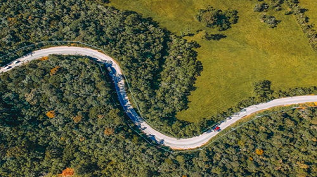Family Funders: Always Important in Rural Communities
Family philanthropy has been present in rural America long before there was even the thought of a field of philanthropy. With a robustly developed body of work that is rural-specific and not just urban downsized, family funders now have the opportunity to support the kind of long-term systems change that we know is necessary for rural communities to spark and sustain.

The history of the United States is marked by wealth created in rural America. Timber and wood products in the northwest and northeast; fossil fuels in Appalachia, the southwest and Rocky Mountains; textiles in the south, among others. Related philanthropic funds have been created alongside these rural industries—often from multi-generational family commitments to these rural communities. With the renewed focus on the challenges and opportunities in rural America, it’s a good time to take a look at how rural philanthropy fits into the philanthropic field as a whole. Importantly, it’s a time to look at how an evolving field of rural philanthropic learning is helping to support more and better rural investments.
One narrative about rural philanthropy is that rural America has received far fewer philanthropic dollars over the years on a proportional basis. This is true. The best data we have indicates that rural philanthropic investment is only at 7% of the total private foundation dollars vs rural America representing 20% of the population – and 90% of the land! An equally accurate narrative, however, is that rural-serving foundations—often family governed—are a strong and consistent presence in helping rural communities face the future with a sense of optimism. Family foundations like the Blandin Foundation, Ford Family Foundation, LOR Foundation, Orton Family Foundation, and the T.L.L. Temple Foundation have long-term commitments to rural community success.
The question is often posed “How does rural philanthropy differ from urban foundation work?”. The answers lie in both tactics and cultural context. Much urban philanthropy is focused on the development and implementation of large scale best practice models around specific issues – e.g. health, education, early childhood development. These grants are made to large staffed non-profits intended to reach thousands if not tens of thousands of participants. The funders often dictate the specifics of the models and the outcomes. Essentially, the funder is contracting for results.
The best rural philanthropic work is fundamentally different. The emphasis is on the place and not on one specific issue or intervention. This reflects how people live and work in rural communities – often wearing multiple hats concurrently, such as a teacher, pastor, coach and civic committee chairperson. There may not be large well-oiled nonprofits to serve as grantees. Instead, funders look to alternative anchor institution grantees like libraries, community colleges or parks and recreation departments and work closely with smaller non-profits that can do the job but need extra support in order to expand their services and influence. Similarly, the scale of the work is necessarily different. While the numbers might be small, the opportunity to do transformational work is significant given the ability to penetrate deeply into the communities’ various systems and networks.
Work around equity is part of many urban funders’ mission and funding strategies. This work can be defined differently around a wide range of issues and outcomes but seeks to reflect long-term inequities in access and opportunity for historically marginalized people. Many rural communities have centuries old divisions around race and ethnicity. Newer versions of these divisions come into play with fast growing immigrant communities throughout rural America. The best rural philanthropic work, however, also recognizes and works towards creating equity around opportunity. This might be broadening the voices that are heard in a rural place; bridging access barriers between urban and rural around broadband and healthcare, or opening up the chances for higher education for those previously shut out. Concurrently, rural communities can be dominated by leadership structures that leave lots of people on the outside looking in. Because of historic roots in these communities, family philanthropy is in the best position to promote and support inclusion for the next version of the communities’ success.
For example, an important new philanthropic dimension in many rural communities is the presence of healthcare conversion foundations. There are now 350+ of these foundations nationally created from the sale of non-profit healthcare assets to for-profit providers. Many of these foundations are rural-based or have a large urban/rural geographic footprint mirroring the service area of the original non-profit. The opportunity for long-term rural-serving family foundations to collaborate and leverage with these newer conversion foundations is an underdeveloped part of the rural philanthropic landscape. In the best circumstances, deeply rooted family funders can serve as mentors and connectors for these newer conversion foundations and help diffuse the confusion and anxiety that can be the result of a large influx of new philanthropic capital into small and often under-resourced rural communities.
Family philanthropy has been present in rural America long before there was even the thought of a field of philanthropy. Families have built schools, hospitals and libraries throughout the United States for many decades. With a robustly developed body of work that is rural-specific and not just urban downsized, family funders now have the opportunity to support the kind of long-term systems change that we know is necessary for rural communities to spark and sustain. There are many willing funding and thought partners out there who want to join this rural commitment.
